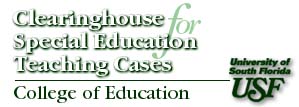
Physical/Neurological Disabilities
Click on the titles to see the full text.
Click on the back button of the browser to return to the index.
Difference of Opinion Jane is an adaptive physical education teacher in a middle school. One of her former students fails his regular PE class and his parents and doctor request that he be returned to her class. When the department head of special education blocks his return due to a technicality, Jane comes to his defense
Ginny
Ginny is a new 9th grade student at Midland High, a school that has received special
recognition as completely accessible to students with physical impairments. Ginny, born
with Spina Bifida, is grossly overweight and confined to a wheelchair. Diane Lane, the
Exceptional Student Education coordinator, is struggling to help Ginny and her family
control her weight and hygiene so that she can participate in a school-to-work program.
Is It Fair?
New technology is currently available to partially restore hearing to children once profoundly deaf. Optimally the implants are done by age two - Rosa Hernandez is now five and the only school to help her adjust is three hours away. A language barrier seems the largest obstacle to hurdle but the sacrifice may be too large.
No Place to Go
In an effort to provide her preschool students with disabilities the opportunity for inclusion, Sally worked to integrate her class with a Headstart program. She engineered the project, relinquished her space and resources to merge with three other teachers in a cooperative venture of inclusion. Initial success turned to despair the second year after students with more severe handicaps were enrolled in the program and the general education teachers balked at working with them.
Christine Wallace is struggling to meet the needs of her general education class with the addition of two children with special needs. One of those children, Katy Alvarez, has it designated in her IEP that she will have the assistance of a special education aide while in Christine's class. Having Katy's aide, Ms. Butler, in the classroom makes Christine's job more manageable, but school administration is reassigning her elsewhere on a regular basis. Christine debates how to handle this delicate issue.
What IS an Appropriate Education?
The Burrows family was coping with their eleven year old daughter’s recent diagnosis of tuberous sclerosis, a rare degenerative neurological disorder. Melissa was experiencing excessive pain and drastic changes in behavior due to the growth of tumors in her brain. The medication prescribed to slow the growth of tumors was indirectly causing obesity. As she became increasingly aggressive, her teachers as well as her family struggled to control her physical outbursts. When a residential placement became a necessity, a dispute arose between the school board and the Burrows over where Melissa should be placed.
Shakira is a physically aggressive fifth grader who is 5 feet tall and weighs 240 pounds. Identified as emotionally handicapped in the 3rd grade, she is often absent and has already failed one grade. No one, including the social workers, the teachers or her mother are able to do much about her absenteeism, or her behavior. Shakira’s teacher Ms. Smith, who is concerned about the effect Shikira is having on her other students, searches for a way to reach her.
Sharon Williams, a veteran kindergarten teacher, is perplexed by the unusual pattern of behaviors one of her students is displaying. As a preschooler, Kevin was reported by his parents, as well as others who knew the family, to have developed good language, cognitive, and social skills. Now he seldom interacts with the other students and often acts as if he doesn't understand what is going on in class.